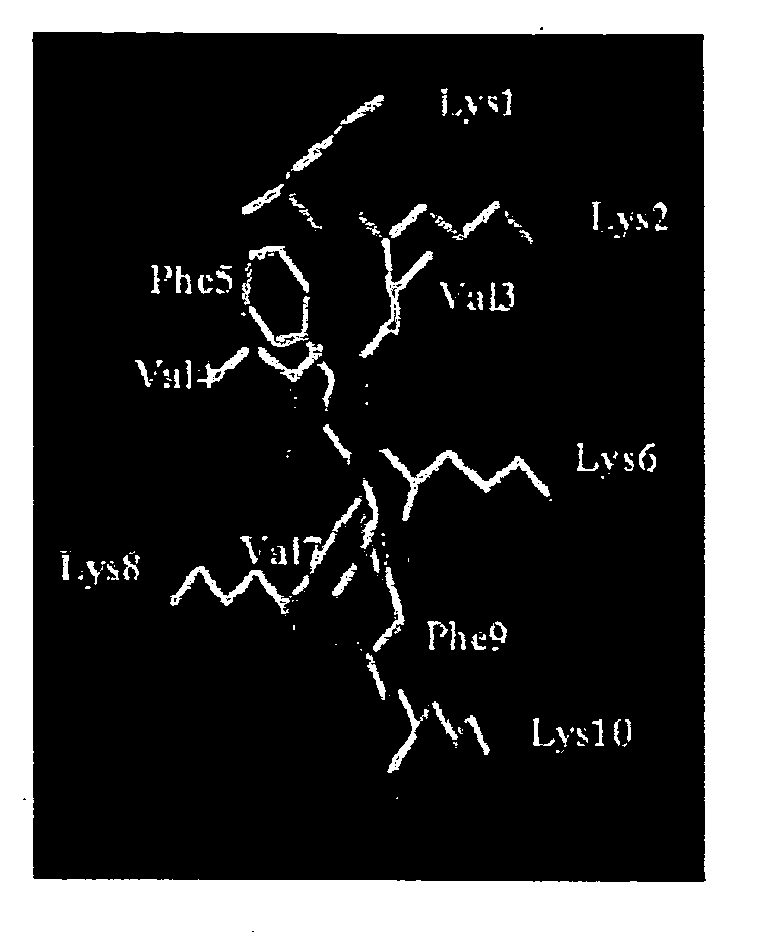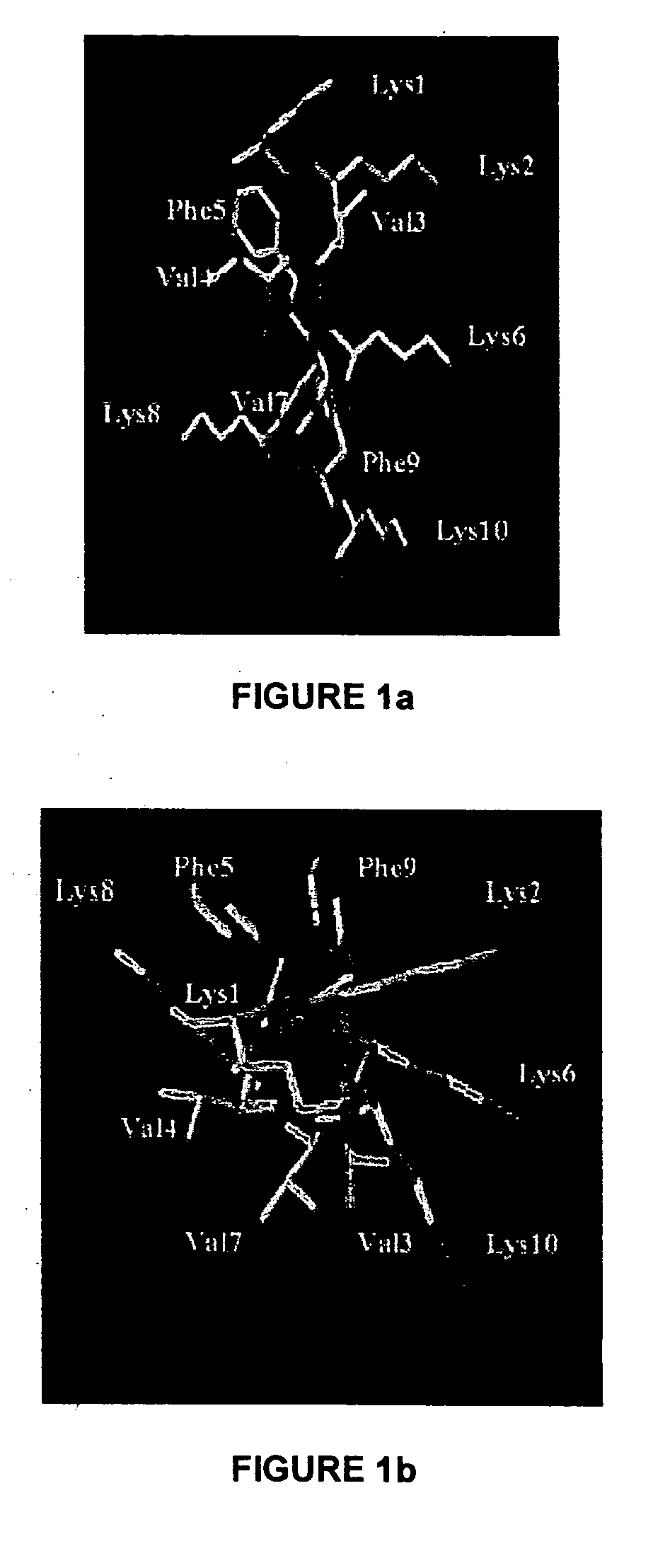Antimircobial peptide and methods of use thereof
a technology of antimicrobial peptides and peptides, which is applied in the field of antimicrobial peptides, can solve the problems of complex structure, difficult and expensive synthesizing, and large peptides, and achieve the effect of novel and effective, novel and effectiv
- Summary
- Abstract
- Description
- Claims
- Application Information
AI Technical Summary
Benefits of technology
Problems solved by technology
Method used
Image
Examples
example 1
Syntheses of the Antimicrobial Decapeptide KSL
[0137] KSL (NH.sub.2-lys-lys-val-val-phe-lys-val-lys-phe-lys-CONH.sub.2) was synthesized by standard solid-phase procedures as described by Hong et al. (1998) by using 9-fluorenylmethoxycarbonyl (Fmoc) chemistry on an automatic peptide synthesizer (Model 90, Advanced ChemTech, Louisville, Ky.). The peptide was synthesized on Rink amide methylbenzhydrylamine (MBHA) resin (AnaSpec, San Jose, Calif.) with the first N-Fmoc-protected Lys attached. The sequential coupling of protected Fmoc amino acid, which included Phe, Lys and Val, was done in N'-tetramethyluronium tetrafluoroborate (TBTU) (Advanced ChemTech) dissolved in N,N-dimethylforamide (DMF) (Advanced ChemTech) containing 0.55 M N,N'-diisopropylethylamine (DIEA) (Advanced ChemTech). Piperdine (20% v / v in DMF) was used to remove the N-terminal Fmoc moiety from the growing peptide prior to subsequent coupling. Completion of coupling reactions was assessed by the ninhydrin test of Kaise ...
example 2
Nuclear Magnetic Resonance (NMR) Studies and Structural Analysis of KSL
[0138] The purified peptide (7 mg) was dissolved in 630 .mu.l of double distilled water and 70 .mu.l of .sup.2H.sub.2O (Cambridge Isotope Laboratories, Woburn, Mass.) with peptide concentration being approximately 5 mM. The pH of the aqueous peptide solution was 3.8. For NMR experiments in dimethyl sulfoxide, the peptide (7 mg) was dissolved in 700 .mu.l of 99.9% (C.sup.2H.sub.3).sub.2SO (Cambridge Isotope Laboratories). The one dimensional (1D) and two dimensional (2D) NMR experiments used for conformational analyses were performed at 30.degree. C. in these solvents. All NMR experiments were carried out at 500 MHz on a Varioa Unity Inova spectrometer equipped with a SUN Sparcstation 20. The 1 D-NMR spectra were recorded with a spectral width of 5000 Hz and a relaxation delay time of 2.5 seconds using 8 K data points zero filled to 32 K before Fourier transformation. All 2D experiments were multiplied by a phase-...
example 3
Media, Culture Conditions and In Vitro Susceptibility Tests
[0150] Todd-Hewitt broth (THB), brain heart infusion (BHI) broth, Todd-Hewitt agar (THA), trypticase soy agar (TSA), lactobacilli MRS (MRS) broth, Actinomyces broth and Mueller-Hinton broth (MHB) were purchased from Becton Dickinson. Blood agar plates (BAP) were prepared by supplementing TSA with 5% sheep blood (PML Microbiologicals). All cultures, except for Actinobacillus actinomycetemcomitans, S. mitis and Actinomyces israelii, were grown at 37.degree. C. in room air. Actinobacillus actinomycetemcomitans cultures were grown on BAP or in MHB supplemented with 15 .mu.g haemin ml.sup.-1 (Sigma), 15 .mu.g .beta.-nicotinamide adenine dinucleotide (NAD) ml.sup.-1 (Sigma) and 5% yeast extract (Becton Dickinson) at 37.degree. C. in 5% CO.sub.2. S. mitis was grown on BAP or in BHI broth at 37.degree. C. in 5% CO.sub.2. Actinomyces israeilli was grown anaerobically in an anaerobic chamber (Coy Laboratory Products) in a 5% CO.sub.2 / ...
PUM
 Login to View More
Login to View More Abstract
Description
Claims
Application Information
 Login to View More
Login to View More - R&D
- Intellectual Property
- Life Sciences
- Materials
- Tech Scout
- Unparalleled Data Quality
- Higher Quality Content
- 60% Fewer Hallucinations
Browse by: Latest US Patents, China's latest patents, Technical Efficacy Thesaurus, Application Domain, Technology Topic, Popular Technical Reports.
© 2025 PatSnap. All rights reserved.Legal|Privacy policy|Modern Slavery Act Transparency Statement|Sitemap|About US| Contact US: help@patsnap.com



